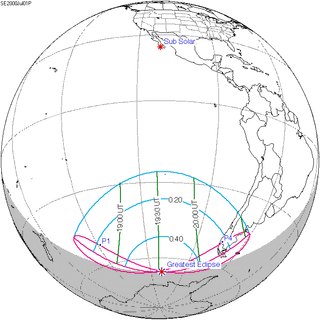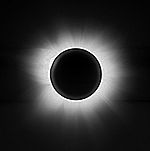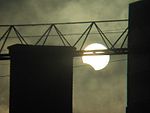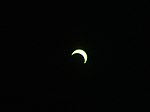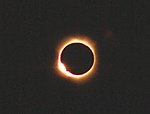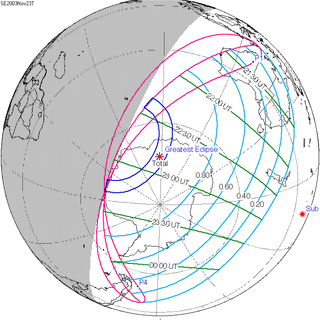
A total solar eclipse took place on Sunday, November 23, 2003, with a magnitude of 1.0379. A solar eclipse occurs when the Moon passes between Earth and the Sun, thereby totally or partly obscuring the image of the Sun for a viewer on Earth. A total solar eclipse occurs when the Moon's apparent diameter is larger than the Sun's, blocking all direct sunlight, turning day into darkness. Totality occurs in a narrow path across Earth's surface, with the partial solar eclipse visible over a surrounding region thousands of kilometres wide. It was visible from a corridor in the Antarctic region. A partial eclipse was seen from the much broader path of the Moon's penumbra, including the southern tip of South America and most of Australia.
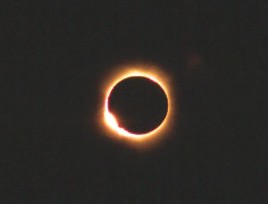
A total solar eclipse took place on Wednesday, December 4, 2002, with a magnitude of 1.0244. A solar eclipse occurs when the Moon passes between Earth and the Sun, thereby totally or partly obscuring the image of the Sun for a viewer on Earth. A total solar eclipse occurs when the Moon's apparent diameter is larger than the Sun's, blocking all direct sunlight, turning day into darkness. Totality occurs in a narrow path across Earth's surface, with the partial solar eclipse visible over a surrounding region thousands of kilometres wide. It was visible from a narrow corridor in southern Africa, the Indian Ocean and southern Australia. A partial eclipse was seen from the much broader path of the Moon's penumbra, including most of Africa and Australia. During the sunset after the eclipse many observers in Australia saw numerous and unusual forms of a green flash.

A total solar eclipse took place on Thursday, June 21, 2001, with a magnitude of 1.0495. It was the first solar eclipse of the 21st century. A solar eclipse occurs when the Moon passes between Earth and the Sun, thereby totally or partly obscuring the image of the Sun for a viewer on Earth. A total solar eclipse occurs when the Moon's apparent diameter is larger than the Sun's, blocking all direct sunlight, turning day into darkness. Totality occurs in a narrow path across Earth's surface, with the partial solar eclipse visible over a surrounding region thousands of kilometres wide.
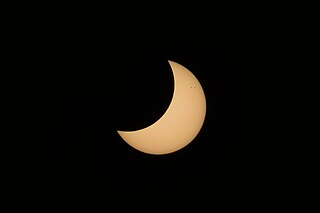
An annular solar eclipse occurred on Tuesday, April 29, 2014. A solar eclipse occurs when the Moon passes between Earth and the Sun, thereby totally or partly obscuring the image of the Sun for a viewer on Earth. An annular solar eclipse occurs when the Moon's apparent diameter is smaller than the Sun's, blocking most of the Sun's light and causing the Sun to look like an annulus (ring). An annular eclipse appears as a partial eclipse over a region of the Earth thousands of kilometres wide. The center of the Moon's shadow missed the Earth's South Pole, but the partial eclipse was visible from parts of Antarctica and Australia, and an annular eclipse was visible from a small part of Antarctica.

An annular solar eclipse occurred on Friday, December 14, 2001. A solar eclipse occurs when the Moon passes between Earth and the Sun, thereby totally or partly obscuring the image of the Sun for a viewer on Earth. An annular solar eclipse occurs when the Moon's apparent diameter is smaller than the Sun's, blocking most of the Sun's light and causing the Sun to look like an annulus (ring). An annular eclipse appears as a partial eclipse over a region of the Earth thousands of kilometres wide. It was visible across the Pacific ocean, southern Costa Rica, northern Nicaragua and San Andrés Island, Colombia. The central shadow passed just south of Hawaii in early morning and ended over Central America near sunset.

An annular solar eclipse occurred at the Moon's ascending node of the orbit on Saturday, May 31, 2003. A solar eclipse occurs when the Moon passes between Earth and the Sun, thereby totally or partly obscuring the image of the Sun for a viewer on Earth. An annular solar eclipse occurs when the Moon's apparent diameter is smaller than the Sun's, blocking most of the Sun's light and causing the Sun to look like an annulus (ring). An annular eclipse appears as a partial eclipse over a region of the Earth thousands of kilometres wide. Annularity was visible across central Greenland, the Faroe Islands, Iceland, Jan Mayen and northern Scotland. Partiality was visible throughout Europe, Asia, and far northwestern Canada.

A partial solar eclipse occurred at the Moon's descending node of the orbit on October 14, 2004. A solar eclipse occurs when the Moon passes between Earth and the Sun, thereby totally or partly obscuring the image of the Sun for a viewer on Earth. A partial solar eclipse occurs in the polar regions of the Earth when the center of the Moon's shadow misses the Earth. It was the 54th eclipse of the 124th Saros cycle, which began with a partial eclipse on March 6, 1049 and will conclude with a partial eclipse on May 11, 2347. The exact time of greatest eclipse took place on Thursday, October 14, 2004, at 02:59:18.4 a.m. UTC, but occurring only 3.9 days before perigee, the Moon's apparent diameter was 1.2% larger than average.

A partial solar eclipse occurred on March 18–19, 2007. A solar eclipse occurs when the Moon passes between Earth and the Sun, thereby totally or partly obscuring the image of the Sun for a viewer on Earth. A partial solar eclipse occurs in the polar regions of the Earth when the center of the Moon's shadow misses the Earth.

An annular solar eclipse occurred at the Moon's ascending node of the orbit on February 7, 2008. A solar eclipse occurs when the Moon passes between Earth and the Sun, thereby totally or partly obscuring the image of the Sun for a viewer on Earth. An annular solar eclipse occurs when the Moon's apparent diameter is smaller than the Sun's, blocking most of the Sun's light and causing the Sun to look like an annulus (ring). An annular eclipse appears as a partial eclipse over a region of the Earth thousands of kilometres wide.

A partial solar eclipse occurred on Friday, July 1, 2011. A solar eclipse occurs when the Moon passes between Earth and the Sun, thereby totally or partly obscuring the image of the Sun for a viewer on Earth. A partial solar eclipse occurs in the polar regions of the Earth when the center of the Moon's shadow misses the Earth. This is the first solar eclipse of Saros series 156, only visible as a partial solar eclipse in a small area south of South Africa and north of Antarctica. At greatest eclipse, the magnitude was just 0.097. It is the first new saros series to begin since saros 155 began with the partial solar eclipse of June 17, 1928. The eclipse belonged to Saros 156 and was number 1 of 69 eclipses in the series. Thus, the 2011 Jul 01 event was the first eclipse of the series.

A partial solar eclipse occurred at the ascending node of the Moon's orbit on Friday, November 25, 2011. A solar eclipse occurs when the Moon passes between Earth and the Sun, thereby totally or partly obscuring the image of the Sun for a viewer on Earth. A partial solar eclipse occurs in the polar regions of the Earth when the center of the Moon's shadow misses the Earth. It was the deepest of the partial solar eclipses in 2011.

A partial solar eclipse occurred on Monday, July 31, 2000. A solar eclipse occurs when the Moon passes between Earth and the Sun, thereby totally or partly obscuring the image of the Sun for a viewer on Earth. A partial solar eclipse occurs in the polar regions of the Earth when the center of the Moon's shadow misses the Earth. It was visible from northern Russia, northeastern Scandinavia, northern Greenland, western Canada, and the northwestern United States.

A total solar eclipse occurred at the Moon's descending node of the orbit on February 16, 1980. A solar eclipse occurs when the Moon passes between Earth and the Sun, thereby totally or partly obscuring the image of the Sun for a viewer on Earth. A total solar eclipse occurs when the Moon's apparent diameter is larger than the Sun's, blocking all direct sunlight, turning day into darkness. Totality occurs in a narrow path across Earth's surface, with the partial solar eclipse visible over a surrounding region thousands of kilometres wide. The path of totality crossed central Africa, southern India, and into China at sunset. The southern part of Mount Kilimanjaro, the highest mountain in Africa, also lies in the path of totality. Occurring only about 24 hours before perigee, the Moon's apparent diameter was larger. This was a Supermoon Total Solar Eclipse because the Moon was just a day before perigee. All of Somalia witness the totality of the solar eclipse.

An annular solar eclipse occurred at the Moon's descending node of the orbit on December 4, 1983. A solar eclipse occurs when the Moon passes between Earth and the Sun, thereby totally or partly obscuring the image of the Sun for a viewer on Earth. An annular solar eclipse occurs when the Moon's apparent diameter is smaller than the Sun's, blocking most of the Sun's light and causing the Sun to look like an annulus (ring). An annular eclipse appears as a partial eclipse over a region of the Earth thousands of kilometres wide. Annularity was visible in Cape Verde, Annobón Island of Equatorial Guinea, Gabon, the People's Republic of Congo, Zaire, northern Uganda, southern Sudan, northwestern Kenya, Ethiopia and Somalia. The Sun's altitude was 66°. Occurring 6.5 days before apogee, the Moon's apparent diameter was near the average diameter.

An annular solar eclipse occurred at the moon's descending node of its orbit on Tuesday, May 10, 1994. It was visible over a wide swath of North America, from Baja California across the Midwest of the United States up through Ontario and Nova Scotia in Canada. Occurring only 1.6 days after apogee, the moon's apparent diameter was smaller than the sun. This solar eclipse belonged to Saros series 128.
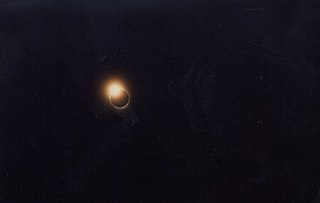
A total solar eclipse occurred on Thursday, November 3, 1994. A solar eclipse occurs when the Moon passes between Earth and the Sun, thereby totally or partly obscuring the image of the Sun for a viewer on Earth. A total solar eclipse occurs when the Moon's apparent diameter is larger than the Sun's, blocking all direct sunlight, turning day into darkness. Totality occurs in a narrow path across Earth's surface, with the partial solar eclipse visible over a surrounding region thousands of kilometres wide. Totality was visible in Peru, northern Chile, Bolivia, northern Argentina, Paraguay including the northeastern part of its capital Asunción, Brazil and Gough Island of British overseas territory of Saint Helena, Ascension and Tristan da Cunha. The Iguazu Falls, one of the largest waterfalls systems in the world, also lies in the path of totality. Totality lasted about 4.4 minutes, so it was a relatively long total solar eclipse. Occurring only 10 hours and 2 minutes before perigee, the moon's apparent diameter was too larger.

An annular solar eclipse occurred on May 30, 1984. A solar eclipse occurs when the Moon passes between Earth and the Sun, thereby totally or partly obscuring the image of the Sun for a viewer on Earth. An annular solar eclipse occurs when the Moon's apparent diameter is smaller than the Sun's, blocking most of the Sun's light and causing the Sun to look like an annulus (ring). An annular eclipse appears as a partial eclipse over a region of the Earth thousands of kilometres wide. Annularity was visible in Mexico, the United States, Azores Islands, Morocco and Algeria. It was the first annular solar eclipse visible in the US in 33 years. The moon's apparent diameter was near the average diameter because occurs 6.7 days after apogee and 7.8 days before perigee.

A hybrid solar eclipse occurred on Thursday, April 20, 2023. A solar eclipse occurs when the Moon passes between Earth and the Sun thereby totally or partly obscuring the Sun for a viewer on Earth. A hybrid solar eclipse is a rare type of solar eclipse that changes its appearance from annular to total and back as the Moon's shadow moves across the Earth's surface. Totality occurs in a narrow path across the surface of the Earth, with the partial solar eclipse visible over a surrounding region thousands of kilometers wide. Hybrid solar eclipses are extremely rare, occurring in only 3.1% of solar eclipses in the 21st century.
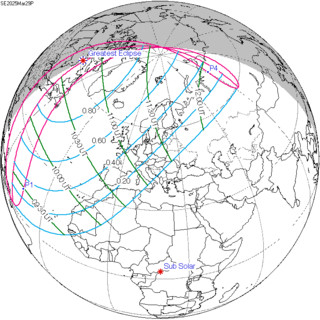
A partial solar eclipse will occur on Saturday, March 29, 2025. A solar eclipse occurs when the Moon passes between Earth and the Sun, thereby totally or partly obscuring the image of the Sun for a viewer on Earth. A partial solar eclipse occurs in the polar regions of the Earth when the center of the Moon's shadow misses the Earth.

An annular solar eclipse occurred at the Moon's descending node of the orbit on February 4–5, 1981. A solar eclipse occurs when the Moon passes between Earth and the Sun, thereby totally or partly obscuring the image of the Sun for a viewer on Earth. An annular solar eclipse occurs when the Moon's apparent diameter is smaller than the Sun's, blocking most of the Sun's light and causing the Sun to look like an annulus (ring). An annular eclipse appears as a partial eclipse over a region of the Earth thousands of kilometres wide. This annular solar eclipse was large because the Moon covered 99.4% of the Sun, with a path width of only 25 km . It was visible in Australia, crossing over Tasmania and southern Stewart Island of New Zealand near sunrise on February 5 (Thursday), and ended at sunset over western South America on February 4 (Wednesday). Occurring only 4 days before perigee, the moon's apparent diameter was larger.
